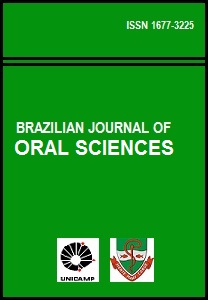Abstract
In the pregnancy many transformations and adaptations occur. These alterations can be predisposing factors to Temporomandibular Disorders (TMD), once the Temporomandibular Joint (TMJ) is vulnerable to intrinsic and extrinsic factors. The proposal of this study was to evaluate the TMJ of pregnant women, checking the prevalence of signs and symptoms of disorder in this joint. To accomplish the study, 22 pregnant were analyzed and divided in first, second, third trimester and those who have baby in the past three months. The dynamics of the mandible movements was observed and the higher amplitude was found in the third trimester. Was noted in the same group a generalized hipermobility and signs of Temporomandibular Disorders, including muscular pain and joint symptoms. It was also observed cervical posture alterations which could be responsible for the presence of symptoms in the others trimesters. Parafunctional habits were also checked in all groups. Therefore, the adaptations presented in the pregnant women such as joint hipermobility, posture alteration, and other modifications can influence the TMJ biomechanic, provoking TMD in pregnant women and in other people who also present these disturbances.References
Rezende J. Obstetrícia. Rio de Janeiro: Guanabara Koogan; 1991.
Landulpho AB, Silva WAB, Silva FA. Análise dos ruídos articulares em pacientes com disfunção temporomandibular tratados com aparelhos interoclusais. JBA. 2003; 3: 112-7.
Souchard PE. Reeducação postural global. São Paulo: Ícone; 1986.
Michelotti A, Manzo P, Farella M, Martina R. occlusion and posture: is there evidence of correlation? Minerva Stomatol. 1999; 48: 525-34.
Darling DW, Kraus S, Glaheen-Wray MB. relationship of head posture and the rest position of the mandibule. J Prosthet Dent. 1984; 52: 111-5.
Hertling D, Kessler RM. management of common musculoskeletal disorders physical therapy - principles and methods. New York: Lippincott; 1996.
Calliet R. Neck and arm pain. 3.ed. FaDavis; 1991.
Dijkstra PU, de Bont LG, van der Weele LT, Boering G. The relationship between temporomandibular joint mobility and peripheral joint mobility reconsidered. Cranio. 1994; 12: 149-54.
Costa AV, Luz JGC, Ferreira FV, Ferreira FAC, Scavone Jr H. Avaliação da mobilidade articular generalizada em pacientes com disfunções temporomandibulares e em indivíduos assintomáticos. Rev Odontol UNICID. 2001; 13: 189-96.
Yap AUJ. Depression and somatization in patients with temporomandibular disorders. J Prosthet Dent. 2002; 88: 479- 84.
Winocur E, Emodi-Perlman A, Finkelstein T, Sharabi-Ventura Y, Gavish A. Do temporomandibular disorders really exist? Refuat Hopeh Vehashinayim. 2003; 20: 62-8.
Glaro AG. Emotional factors in temporomandibular joint disorders. J Indiana Dent Assoc. 2001; 79: 20-3.
Siqueira JTT, Ching LH. Dor orofacial/ATM: bases para diagnóstico clínico. Curitiba: Maio; 1999.
Barbosa GAS, Badaró Filho CR, Fonseca RB, Soares CJ, Neves FD, Fernandes Neto AJ. Distúrbios oclusais: associação com a etiologia ou uma conseqüência das disfunções temporomandibulares? JBA. 2003; 3: 158-63.
Cooper BC, Cooper DL. Recognizing otolaryngology symptoms in patients with temporomandibular disorders. Cranio. 1993; 11: 260-7.
Oliveira MFV. Dor crônica orofacial – a interface do profissional da saúde mental com o doente, a família e a equipe multidisciplinar. Rev Simbidor. 2002; 3: 11-8.
Oliver J, Middleditch A. Anatomia funcional da coluna vertebral. Rio de Janeiro: Revinter; 1998.
Souza ELBL. Fisioterapia aplicada à obstetrícia – aspectos de ginecologia e neonatologia. 3.ed. Rio de Janeiro: Medsi; 2002.
Westling L, Helkimo MJ. Maximum jaw opening capacity in adolescents em relation to general joint mobility. J Oral Rehabil. 1992; 9: 485-94.
Perrini F. Generalized joint laxity and temporomandibular disorders. J Orofac Pain. 1997; 11: 215-21.
The Brazilian Journal of Oral Sciences uses the Creative Commons license (CC), thus preserving the integrity of the articles in an open access environment.

